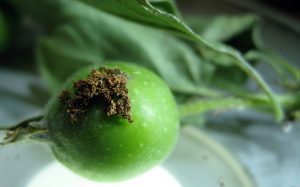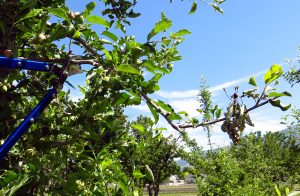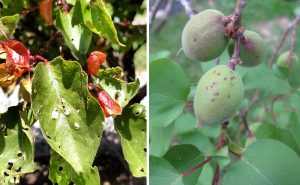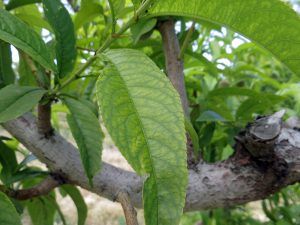In this Issue
- Codling moth: most locations are within the period of greatest egg hatch; keep fruit protected
- Fire blight: continue to prune out infections
- Coryneum blight: if present, protect fruit before or right after heavy rainfall
- Iron deficiency
APPLE, PEAR
Codling Moth

For updated dates of codling moth activity, click here to open a pdf file (in a new window).
Most areas of northern Utah are just starting the “period of greatest egg hatch”. This is the time when up to 75% of codling moth eggs hatch into larvae. Therefore, protection of fruit during this time period will help prevent damage. If it has been a while since you applied a treatment, and your fruit was infested last year, you might consider another application during this time period.
The egg hatch for this first generation will be ending in late June to early July, and a second generation of moths will lay eggs that will begin to hatch in early to mid-July. Between the end of the first generation and the beginning of the second generation, there is no need for the fruit to be protected.
Treatment
Residential: See the advisory from May 11 (scroll down) that includes a table of products and how long they provide protection.
Commercial: Click here for options.
Fire Blight
Continue to prune out infections

If any fire blight infections occurred during bloom, they are clearly visible in apple and pear trees now. Inspect your trees for wilting foliage around old fruit/flower clusters.
If you find any, it is important that these are removed because otherwise, the bacteria may continue to spread within the tree and kill additional branches. In addition, if infected areas of the tree are left, they will contribute to spread of the pathogen to other parts of the tree or orchard next spring.
Treatment
- Prune in dry weather only.
- To be safe, wipe pruners with disinfecting wipes between cuts.
- For infections that are caught early, remove twice the length of the visible symptoms.
- If rainfall is predicted after pruning, remove the debris from the ground rather than leaving it in the orchard. (If conditions are hot and dry, it is OK to leave the debris on the ground and mulch it.)
PEACH/NECTARINE, APRICOT
Coryneum Blight (Shothole)

Rain events in May have contributed to spread of the fungal spores that cause coryneum blight (also known as shothole blight), leading to heavy infections on leaves and fruit in some areas. Leaves may turn yellow and drop early.
Unfortunately, there is nothing to be done about existing infections. For backyard settings, remove the most heavily infected fruit and rake up fallen leaves to prevent further spread.
For the remainder of the season, new infections can occur when temperatures are warm (above 75) combined with a steady rain lasting 4 to 6 hours. A fungicide spray is required to prevent these infections from happening. Rain is predicted for some areas on Monday, June 13.
Treatment
Residential: Captan is only effective when applied before a rain. Spectracide Immunox or Monterey F-stop can be applied after a rain, but may not provide complete prevention of infection.
Commercial growers can find options by clicking here.
ALL FRUIT TREES
Iron Deficiency

Iron deficiency of foliage is a common sight in Utah orchards, and an issue that both commercial and residential growers have to deal with every year.
Iron deficiency causes foliage to become yellow between the veins, also known as iron chlorosis. It is not caused by a lack of iron in the soil, but rather the soil pH (which in Utah, ranges from 7.5 to 8.5). In high pH, iron is insoluble, and therefore not available for root absorption. Because irrigation water is also very alkaline, trying to manage iron deficiency by reducing soil pH is impossible.
Iron is a nutrient necessary for the formation of chlorophyll. Lack of chlorophyll means reduced photosynthesis, and reduced tree vigor. Some trees are genetically more susceptible to nutrient deficiencies than others.
Treatment
- To prevent or treat iron deficiency at this time of year, iron can be sprayed on the foliage. If it is not incorporated into the product, add a spreader-sticker. Reapply at approximately 10- to 21-day intervals. The drawback of foliar sprays is that staining of fruit can occur.
- A better treatment is to apply chelated iron (which is not affected by soil pH and readily available for absorption) to the root zone in the spring before budbreak.
- Keep in mind that results are temporary and must be repeated each year.
- Residential growers can use Liquid Iron, Ironite, or other iron for foliar spray now. Next spring, use Miller’s Ferriplus, Sequestrene/Sprint 138, or Lily Miller Sequester for soil application.
- Commercial growers can use the above products, or see the Intermountain Tree Fruit Production website nutrition section.
